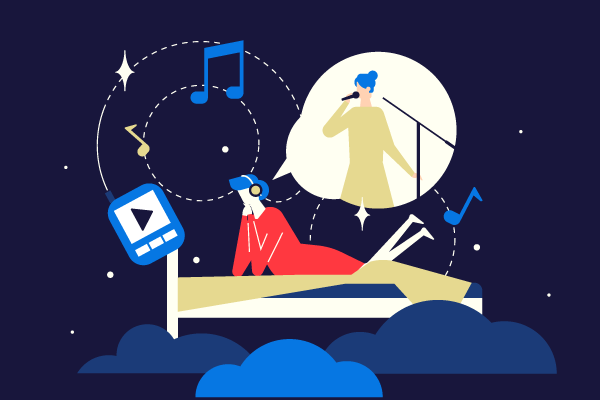Observation
Listening to Music Near Bedtime Could Lure Sleep-Disrupting ‘Earworms’

Most people have had a song stuck in their heads at one time or another. These persistent melodies, commonly called earworms, can be amusing distractions or intrusive annoyances.
New research published in the journal Psychological Science, however, reveals that earworms can sometimes interject themselves into our dreams, where they can negatively impact our quality of sleep.
“Our brains continue to process music even when none is playing, including apparently while we are asleep,” said Michael Scullin, a sleep researcher at Baylor University and lead author on the article. “Everyone knows that music listening feels good. Adolescents and young adults routinely listen to music near bedtime. But sometimes you can have too much of a good thing. The more you listen to music, the more likely you are to catch an earworm that won’t go away at bedtime. When that happens, chances are your sleep is going to suffer.”
According to the researchers, people who experience earworms regularly at night—one or more times per week—are six times more likely to have poor sleep quality compared to people who rarely experience earworms. Surprisingly, the study, which involved both a survey and a laboratory experiment, found that some instrumental music is more likely to lead to earworms and disrupt sleep quality than lyrical music.
The survey involved 209 participants who completed a series of questionnaires on sleep quality, music listening habits, and earworm frequency, including how often they experienced an earworm while trying to fall asleep, waking up in the middle of the night, and immediately upon waking in the morning.
In the experimental study, 50 participants were brought into Scullin’s Sleep Neuroscience and Cognition Laboratory at Baylor, where the research team attempted to induce earworms to determine how it affected sleep quality. Polysomnography—a comprehensive test and the gold standard measurement for sleep—was used to record the participants’ brain waves, heart rate, breathing, and more while they slept.
“Before bedtime, we played three popular and catchy songs—Taylor Swift’s ‘Shake It Off,’ Carly Rae Jepsen’s ‘Call Me Maybe,’ and Journey’s ‘Don’t Stop Believin’,” Scullin said. “We randomly assigned participants to listen to the original versions of those songs or the de-lyricized instrumental versions of the songs. Participants responded whether and when they experienced an earworm. Then we analyzed whether that impacted their nighttime sleep physiology. People who caught an earworm had greater difficulty falling asleep, more nighttime awakenings, and spent more time in light stages of sleep.”
Additionally, the researchers took EEG readings—records of electrical activity in the brain—to examine physiological markers of sleep-dependent memory consolidation. Memory consolidation is the process by which temporary memories are spontaneously reactivated during sleep and transformed into a more long-term form.
“We thought that people would have earworms at bedtime when they were trying to fall asleep, but we certainly didn’t know that people would report regularly waking up from sleep with an earworm. But we saw that in both the survey and experimental study,” Scullin said.
Participants who had a sleep earworm showed more slow oscillations during sleep, a marker of memory reactivation. The increase in slow oscillations was dominant over the region corresponding to the primary auditory cortex, which is implicated in earworm processing when people are awake.
“Almost everyone thought music improves their sleep, but we found those who listened to more music slept worse,” Scullin said. “What was really surprising was that instrumental music led to worse sleep quality—instrumental music leads to about twice as many earworms.”
The study found that individuals with greater music listening habits experienced persistent earworms and a decline in sleep quality. These results are contrary to the idea of music as a hypnotic that might help sleep. Health organizations commonly recommend listening to quiet music before bedtime—recommendations that largely arise from self-reported studies. Instead, Scullin has objectively measured that the sleeping brain continues to process music for several hours, even after the music stops.
Knowing that earworms negatively affect sleep, Scullin recommends first trying to moderate music listening or taking occasional breaks if bothered by earworms. Timing of music also is important—try to avoid it before bed.
“If you commonly pair listening to music while being in bed, then you’ll have that association where being in that context might trigger an earworm even when you’re not listening to music, such as when you’re trying to fall asleep,” Scullin said.
Another way to get rid of an earworm is to engage in cognitive activity—fully focusing on a task, problem, or activity helps to distract your brain from earworms. Near bedtime, rather than engaging in a demanding activity or something that would disrupt your sleep, like watching TV or playing video games, Scullin suggests spending five to 10 minutes writing out a to-do list and putting thoughts to paper. A previous study by Scullin—partially funded by a National Institutes of Health grant and the Sleep Research Society Foundation—found that participants who took five minutes to write down upcoming tasks before bed helped “offload” those worrying thoughts about the future and led to faster sleep.
Feedback on this article? Email apsobserver@psychologicalscience.org or scroll down to comment.
Reference
Scullin, M. K., Gao, C., & Fillmore, P. (2021). Bedtime music, involuntary musical imagery, and sleep. Psychological Science. Advance online publication. https://doi.org/10.1177/0956797621989724





APS regularly opens certain online articles for discussion on our website. Effective February 2021, you must be a logged-in APS member to post comments. By posting a comment, you agree to our Community Guidelines and the display of your profile information, including your name and affiliation. Any opinions, findings, conclusions, or recommendations present in article comments are those of the writers and do not necessarily reflect the views of APS or the article’s author. For more information, please see our Community Guidelines.
Please login with your APS account to comment.